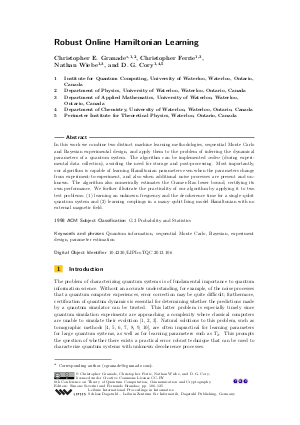Robust Online Hamiltonian Learning
Authors Christopher E. Granade, Christopher Ferrie, Nathan Wiebe, D. G. Cory
-
Part of:
Volume:
8th Conference on the Theory of Quantum Computation, Communication and Cryptography (TQC 2013)
Part of: Series: Leibniz International Proceedings in Informatics (LIPIcs)
Part of: Conference: Conference on the Theory of Quantum Computation, Communication and Cryptography (TQC) - License:
 Creative Commons Attribution 3.0 Unported license
Creative Commons Attribution 3.0 Unported license
- Publication Date: 2013-11-13
File

PDF
LIPIcs.TQC.2013.106.pdf
- Filesize: 1.6 MB
- 20 pages
Document Identifiers
Subject Classification
Keywords
- Quantum information
- sequential Monte Carlo
- Bayesian
- experiment design
- parameter estimation
Metrics
- Access Statistics
-
Total Accesses (updated on a weekly basis)
0Document
0Metadata
Abstract
In this work we combine two distinct machine learning methodologies, sequential Monte Carlo and Bayesian experimental design, and apply them to the problem of inferring the dynamical parameters of a quantum system. The algorithm can be implemented online (during experimental data collection), avoiding the need for storage and post-processing. Most importantly, our algorithm is capable of learning Hamiltonian parameters even when the parameters change from experiment-to-experiment, and also when additional noise processes are present and unknown. The algorithm also numerically estimates the Cramer-Rao lower bound, certifying its own performance. We further illustrate the practicality of our algorithm by applying it to two test problems: (1) learning an unknown frequency and the decoherence time for a single-qubit quantum system and (2) learning couplings in a many-qubit Ising model Hamiltonian with no external magnetic field.
Cite As Get BibTex
Christopher E. Granade, Christopher Ferrie, Nathan Wiebe, and D. G. Cory. Robust Online Hamiltonian Learning. In 8th Conference on the Theory of Quantum Computation, Communication and Cryptography (TQC 2013). Leibniz International Proceedings in Informatics (LIPIcs), Volume 22, pp. 106-125, Schloss Dagstuhl – Leibniz-Zentrum für Informatik (2013)
https://doi.org/10.4230/LIPIcs.TQC.2013.106
BibTex
@InProceedings{granade_et_al:LIPIcs.TQC.2013.106,
author = {Granade, Christopher E. and Ferrie, Christopher and Wiebe, Nathan and Cory, D. G.},
title = {{Robust Online Hamiltonian Learning}},
booktitle = {8th Conference on the Theory of Quantum Computation, Communication and Cryptography (TQC 2013)},
pages = {106--125},
series = {Leibniz International Proceedings in Informatics (LIPIcs)},
ISBN = {978-3-939897-55-2},
ISSN = {1868-8969},
year = {2013},
volume = {22},
editor = {Severini, Simone and Brandao, Fernando},
publisher = {Schloss Dagstuhl -- Leibniz-Zentrum f{\"u}r Informatik},
address = {Dagstuhl, Germany},
URL = {https://drops.dagstuhl.de/entities/document/10.4230/LIPIcs.TQC.2013.106},
URN = {urn:nbn:de:0030-drops-43185},
doi = {10.4230/LIPIcs.TQC.2013.106},
annote = {Keywords: Quantum information, sequential Monte Carlo, Bayesian, experiment design, parameter estimation}
}
